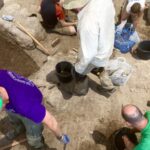Occasionally, I like to dig into what’s being dug lately, highlighting recent archaeological discoveries in Israel and elsewhere.
Teams in Egypt, for example, have been turning up scores of undisturbed coffins in Saqqara, an ancient necropolis south of Cairo, where unnumbered tombs lie buried beneath deep layers of desert sands.
A documentary recently posted on Netflix highlighted the 2018 discovery of an impressive intact tomb from the Fifth Dynasty of Egypt’s Old Kingdom (2686-2181 BCE), and Egypt’s Tourism and Antiquities ministry recently set up a temporary display to show off scores of coffins and gilded statues turned up during the past season’s digging. Those finds dated to Egypt’s Late Period (664-332 BCE) and the Ptolemaic dynasty that followed (320-30 BCE).
A smaller but perhaps more meaningful discovery recently turned up in the Golan Heights, which Israel seized from Syria during the 1967 Six-Day War and has occupied since. Israel’s claim of sovereignty over the territory has been rejected internationally.
The only exception is the United States, which had also refused to affirm Israeli sovereignty until Donald Trump did so with an executive order in March 2019, much to the delight of his evangelical fans.
Politics rears its ugly head everywhere, even in archaeology.
A religious settlement and farming community has grown up in a beautiful part of the hilly area. Known as Haspin, but often called “Hispin,” the community has been growing and wanted to expand its footprint.
As with all construction projects in land controlled by Israel, however, an archaeological salvage operation had to be done to make sure the expansion did not cover important historical remains.
An excavation mounted by the Israel Antiquities Association, using locals to provide the labor, turned up a surprise: what appeared to be a small fortress dating back to the 10th and 11th centuries BCE – the time of David and Solomon.
But to whom did the fortress belong? A large stone provides the primary clue: It is engraved with two schematic horned figures that apparently represent a god. A flat stone nearby may have been used as an offering table.
The simplistic figures are similar to a more detailed image that turned up inside the impressive basalt gate of et-Tell during excavations several years ago. The et-Tell site, a few miles north of the Sea of Galilee, is thought by some to have been the New Testament city of Bethsaida. The earliest layers, though, go back to the 10th century BCE, and it is widely regarded as the leading city of the kingdom of Geshur, a small Aramean state that emerged about the same time as Israel.

A horned god on a basalt slab from Geshur, now in the Israel Museum. (Photo: Tony W. Cartledge)
The bull-headed god, which appears to be wearing a sword, may represent the storm god, Hadad, a favorite of the Arameans, or possibly a moon god, which was also popular. An information card by the stone slab in the Israel Museum suggests that the unusual figure may represent a fusion between the two.
And why should we care about Geshur?
David, according to 2 Samuel 3:3, married Maacah, the daughter of the king of Geshur, a practice that was common to seal political alliances. Maacah was the mother of both Tamar, who was raped by her half-brother Amnon (2 Samuel 13:1-20), and her brother Absalom.
Absalom took in his sister and took vengeance on Amnon by having him murdered (2 Samuel 13:20-29), then fled to his mother’s home in Geshur for three years (2 Samuel 13:34-39).
The recent find bears no sign saying, “Welcome to Geshur,” so it cannot be attributed with certainty to the Geshurites. Still, it is in the right place at the right time to fit the biblical account.
That’s the sort of thing that’s bound to send fans of Israel’s history right over the moon, but it also puts them on the horns of a dilemma. Do we celebrate a find that resulted from a settlement regarded by everyone but Israel and the U.S. as illegal?
Politics. Everywhere.
Sigh.





